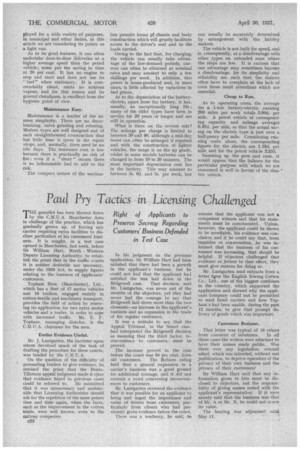Is the Electric the Future Light Van ?
Page 115

Page 116

If you've noticed an error in this article please click here to report it so we can fix it.
Mang Operators and Not a Few Makers Believe that the Battery-electric Will Soon Enjoy Conside)..able Popularity
• 'THE battery-electric vehicle in its 1 various guises is making slow but sure progress. Considering the sales, the number of reputable makers is comparatively high, and this in itself is an indication, of the confidence which is felt by them regarding its. future.
Until recently, and even now in certain areas, some difficulties have been experienced in connection with facilities for recharging the batteries, but the points at which this can be effected are steadily increasing in number, and the price at which current can be obtained is becoming more uniform. The latter tendency will be accentuated by the averaging of the cost of electricity which is taking place throughout the country.
The electric vehicle is not a type for long-distance work, particularly in hilly country. Its metier is in local delivery and collection work, where its rapid acceleration and extremely, easy manceuvrability render it ideal for service in congested traffic.
Although the battery-electric is, emc57 ployed for a wide variety of purposes, . in municipal and other duties, in this article we are considering its points as a light van.
As to its good features, it can often undertake door-to-door deliveries at a higher average speed than the petrol vehicle ; some put the saving in time at 20 per cent. It has no engine to stop and start and does not use its " fuel" when stationary. It is commendably silent, emits no noxious vapour, and for thin reason and its general cleanliness, is excellent from the hygienic point of view.
Maintenance Easy.
Maintenance is a matter of the utmost simplicity. There are no decarbonizing, valve grinding and reboring. Modern types are well designed and of such straightforward construction that but little time is spent in the repair shops, and, normally, there need be no idle days. The insurance cost is /ow because there is practically no risk of fire ; even if a " short " occurs there is no inflammable fuel to add to the risk.
The compact nature of the mechan
ism permits forms of chassis and body construction which will greatly facilitate access to the driver's seat and to the loads carried.
Owing to the fact that, for charging, the vehicle can usually take advantage of the low-demand periods, current can often be obtained at nominal rates and may amount to only a few shillings per week. In addition, this power is home-produced and, in most cases, is little affected by variations in fuel prices.
As to the depreciation of the batteryelectric, apart from' thebattery, it has, usually, an exceptionally long life ; many of the older types have been in service for 20 years or longer and are still in operation.
What is there on the reverse side? The mileage per charge is limited to between 30 and 40, although a mid-clay boost can often be arranged if required and with the construction of lighter vehicles, the range is on the up grade, whilst in some models batteries can be changed in from 10 to 20 minutes. The most important depreciation cost lies in the battery. This may amount to between 3s. ed. and 5s. per week, but can usually be accurately determined by arrangement with the battery makers.
The vehicle is not built for speed, and is, consequently, at a disadvantage with other types on extended runs where the stops are few. It is curious that one advantage may sometimes become a disadvantage, for its simplicity and reliability are such that the makers often have to complain at the lack of even those small attentions which are essential.
Cheap to Run.
As to operating costs, the average for a 1-ton battery-electric running 200 miles per week totals 5.9(kl. per mile. A petrel vehicle of corresponding capacity and mileage averages 6.47d. per mile, so that the actual saving on the electric type is just over a half-penny per mile. Considering runmug costs alone, the corresponding figures for the electric are 1.19d. per mile and forthe petrol vehicle 2.23d.
Summing up the pros and cons, it would appear that the balance for the particular purpose with which we are concerned is well in favour of the electric vehicle.








































































































































































